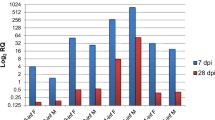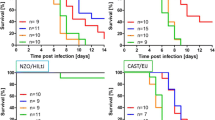Summary
The genetics of resistance to the Moscow strain of ectromelia virus was examined in crosses derived from resistant C57BL/6 (B6) and susceptible DBA/2 (D2) mice. Infection with 101 to 105 PFU of virus resulted in mortalities of 90 to 100% of D2, 0% of B6 and 0 to 3% of (B6 × D2) F1 mice by day 21. Among F1 × D2 backcross progeny, 49% of male and 18% of female mice died. Reciprocal backcrossing did not alter male or female mortality rates. These data are consistent with a single autosomal dominant gene controlling resistance to ectromelia in male mice and at least one additional dominant sex-limited gene controlling resistance in female mice. Fewer male F2 mice died than were predicted based on single-locus control and 32% of recombinant inbred (RI) strains derived from B6 and D2 progenitors expressed non-parental phenotypes. Therefore, additional resistance genes, not expressed in backcross mice, were apparently expressed in F2 mice and RI strains.
Similar content being viewed by others
References
Bang FB, Warwick A (1960) Mouse macrophages as host cells for the mouse hepatitis virus and the genetic basis of their susceptibility. Proc Natl Acad Sci USA 46: 1065–1075
Bhatt PN, Jacoby RO (1987) Mousepox in inbred mice innately resistant or susceptible to lethal infection with ectromelia virus I. Clinical responses. Lab Anim Sci 37: 11–15
Bhatt PN, Jacoby RO, Gras L (1988) Mousepox in inbred mice innately resistant or susceptible to lethal infection with ectromelia virus IV. Studies with the Moscow strain. Arch Virol 100: 221–230
Elseth GD, Baumgardner KD (1984) Genetics. Addison-Wesley, Reading, p 210
Fenner F (1948) The clinical features of mouse-pox (infectious ectromelia of mice) and the pathogenesis of disease. J Pathol Bacteriol 60: 529–552
Fenner F (1948) The pathogenesis of the acute exanthems. An interpretation based upon experimental investigations with mouse-pox (infectious ectromelia of mice). Lancet ii: 915–920
Fenner F (1981) Mousepox (infectious ectromelia): past, present and future. Lab Anim Sci 31: 553–559
Huber SA, Job LP, Auld KR, Woodruff JF (1981) Sex-related differences in the rapid production of cytotoxic spleen cells active against uninfected myofibers during coxsackievirus B-3 infection. J Immunol 126: 1336–1340
Jacoby RO, Bhatt PN, Johnson EA, Paturzo FX (1983) Pathogenesis of vaccinia (IHD-T) virus infection in BALB/cAnN mice. Lab Anim Sci 33: 435–441
Jacoby RO, Bhatt PN (1987) Mousepox in inbred mice innately resistant or susceptible to lethal infection with ectromelia virus II. Pathogenesis. Lab Anim Sci 37: 16–22
O'Neill HC, Blanden RV (1983) Mechanisms determining innate resistance to ectromelia virus infection in C57BL mice. Infect Immun 41: 1391–1394
Pedersen EB, Haahr S, Mogensen SC (1983) X-linked resistance of mice to high doses of herpes simplex virus type 2 correlates with early interferon production. Infect Immun 42: 740–746
Wallace GD (1981) Mouse pox threat. Science 211: 438
Wallace GD, Buller RML, Morse HC III (1985) Genetic determinants of resistance to ectromelia (mousepox) virus-induced mortality. J Virol 55: 890–891
Zawatzky R, Kirchner H, DeMaeyer-Guignard J, DeMaeyer E (1982) An X-linked locus influences the amount of circulating interferon induced in the mouse by herpes simplex virus type 1. J Gen Virol 63: 325–332
Author information
Authors and Affiliations
Rights and permissions
About this article
Cite this article
Brownstein, D., Bhatt, P.N. & Jacoby, R.O. Mousepox in inbred mice innately resistant or susceptible to lethal infection with ectromelia virus V. Genetics of resistance to the Moscow strain. Archives of Virology 107, 35–41 (1989). https://doi.org/10.1007/BF01313876
Received:
Accepted:
Issue Date:
DOI: https://doi.org/10.1007/BF01313876




